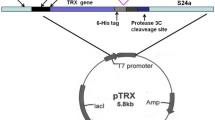Abstract
Attempts were made to synthesize seven analogs of µ-conotoxin GIIIA, a specific blocker of muscle sodium channels, by replacing the three Hyp residues (Hyp6, Hyp7, and Hyp17) with various amino acids. Replacement with Ala residue at these positions resulted in a very low isolation yield, suggesting that these three Hyp residues are essential for the folding of the molecule. CD spectra of the synthesized analogs suggest that, once synthesized, the replacement did not affect the three dimensional structure. The inhibitory effects on the twitch contractions of the rat diaphragm showed that the hydroxyl group at side chains of Hyp residues are not essential for the activity.





Similar content being viewed by others
Abbreviations
- Boc:
-
t-Butoxycarbonyl
- CD:
-
Circular dichroism
- FAB-MS:
-
Fast atom bombardment-mass spectrometry
- µ-GIIIA:
-
µ-Conotoxin GIIIA
- Sar:
-
Sarcosine (N-methylglycine)
- RP-HPLC:
-
Reversed phase high performance liquid chromatography
- MBHA:
-
4-Methylbenzhydrylamine
- NMR:
-
Nuclear magnetic resonance
References
Becker S, Prusak-Sochaczewski E, Zamponi G, Beck-Sickinger AG, Gordon RD, French RJ (1992) Action of derivatives of µ-conotoxin GIIIA on sodium channels. Single amino acid substitutions in the toxin separately affect association and dissociation rates. Biochemistry 31:8229–8238
Catterall WA (1988) Structure and function of voltage-sensitive ion channels. Science 242:50–61
Chahine M, Chen L-Q, Fotouchi N, Walsky R, Fry D, Santarelli V, Horn R, Kallen RG (1995) Characterizing the µ-conotoxin binding site on voltage-sensitive sodium channels with toxin analogs and channel mutations. Recept Channels 3:161–174
Chang NS, French RJ, Lipkind GM, Fozzard HA, Dudley S Jr (1998) Predominant interactions between µ-conotoxin Arg-13 and the skeletal muscle Na+ channel localized by mutant cycle analysis. Biochemistry 37:4407–4419
Cruz LJ, Gray WR, Olivera BM, Zeikus RD, Kerr L, Yoshikami D, Moczydlowski E (1985) Conus geographus toxins that discriminate between neuronal and muscle sodium channels. J Biol Chem 260:9280–9288
Dudley SC Jr, Todt H, Lipkind G, Fozzard HA (1995) A µ-conotoxin-insensitive Na+ channel mutant: possible localization of a binding site at the outer vestibule. Biophys J 69:1657–1665
French RJ, Prusak-Sochaczewski E, Zamponi GW, Becker S, Kularatna AS, Horn R (1996) Interactions between a pore-blocking peptide and the voltage sensor of the sodium channel: an electrostatic approach to channel geometry. Neuron 16:407–413
Gray WR, Olivera BM, Cruz LJ (1988) Peptide toxins from venomous Conus snails. Annu Rev Biochem 57:665–700
Hidaka Y, Sato K, Nakamura H, Ohizumi Y, Kobayashi J, Shimonishi Y (1990) Disulfide pairings in geographutoxin I, a peptide neurotoxin from Conus geographus. FEBS Lett 264:29–32
Kim JI, Takahashi M, Ogura A, Kohno T, Kudo Y, Sato K (1994) Hydroxyl group of Tyr13 is essential for the activity of ω-conotoxin GVIA, a peptide toxin for N-type calcium channel. J Biol Chem 269:23876–23878
Lancelin J-M, Kohda D, Tate S, Yanagawa Y, Abe T, Satake M, Inagaki F (1991) Tertiary structure of conotoxin GIIIA in aqueous solution. Biochemistry 30:6908–6916
Lew MJ, Flinn JP, Pallaghy PK, Murphy R, Whorlow SL, Wright CE, Norton RS, Angus JA (1997) Structure-function relationships of ω-conotoxin GVIA. Synthesis, structure, calcium channel binding, and functional assay of alanine-substituted analogues. J Biol Chem 272:12014–12023
Moczydlowski E, Olivera BM, Gray WR, Strichartz GR (1986) Discrimination of muscle and neuronal Na-channel subtypes by binding competition between [3H]saxitoxin and µ-conotoxins. Proc Natl Acad Sci USA 83:5321–5325
Nakamura H, Kobayashi J, Ohizumi Y, Hirata Y (1983) Isolation and amino acid composition of geographutoxin I and II form the marine snail Conus Geographus. Experientia 39:590–591
Olivera BM, Gray WR, Zeikus R, McIntosh JM, Varga J, Rivier J, de Santos V, Cruz LJ (1985) Peptide neurotoxins from fish-hunting cone snails. Science 230:1338–1343
Olivera BM, Rivier J, Clark C, Ramilo CA, Corpuz GP, Abogadie FC, Mena EE, Woodward SR, Hilliyard DR, Cruz LJ (1990) Diversity of Conus neuropeptides. Science 249:257–263
Sato S, Nakamura H, Ohizumi Y, Kobayashi J, Hirata Y (1983) The amino acid sequences of homologous hydroxyproline-containing myotoxin from the marine snail Conus Geographus venom. FEBS Lett 155:277–280
Sato K, Ishida Y, Wakamatsu K, Kato R, Honda H, Ohizumi Y, Nakamura H, Ohya M, Lancelin J-M, Kohda D, Inagaki F (1991) Active site of µ-conotoxin GIIIA, a peptide blocker of muscle sodium channels. J Biol Chem 266:16989–16991
Sato K, Yamaguchi Y, Ishida Y (2014) Roles of individual disulfide bridges in the conformation and activity of µ-conotoxin GIIIA, a peptide blocker of muscle sodium channels. Int J Pept Res Ther 20:253–258. doi:10.1007/s10989-013-9389-1
Terlau H, Olivera BM (2004) Conus venoms: a rich source of novel ion channel-targeted peptides. Physiol Rev 84:41–68
Wakamatsu K, Kohda D, Hatanaka H, Lancelin J-M, Ishida Y, Oya M, Nakamura H, Inagaki F, Sato K (1992) Structure-activity relationships of µ-conotoxin GIIIA: structure determination of active and inactive sodium channel blocker peptides by NMR and simulated annealing calculations. Biochemistry 31:12577–12584
Acknowledgments
The authors wish to express their appreciation to Dr. Hideyoshi Higashi of Mitsubishi Kagaku Institute of Life Sciences for providing measurements of FAB–MS and also to Prof. Scott Pugh of Fukuoka Women’s University for correction of English usage of this manuscript.
Conflict of interest
All authors declare that they have no conflict of interest.
Ethical standards
All institutional and national guidelines for the care and use of laboratory animals were followed. This article does not include any studies using human subjects.
Author information
Authors and Affiliations
Corresponding author
Rights and permissions
About this article
Cite this article
Sato, K., Yamaguchi, Y., Ohtake, A. et al. Roles of Hyp Residues in the Folding and Activity of μ-Conotoxin GIIIA, a Peptide Blocker of Muscle Sodium Channels. Int J Pept Res Ther 20, 435–440 (2014). https://doi.org/10.1007/s10989-014-9407-y
Accepted:
Published:
Issue Date:
DOI: https://doi.org/10.1007/s10989-014-9407-y




